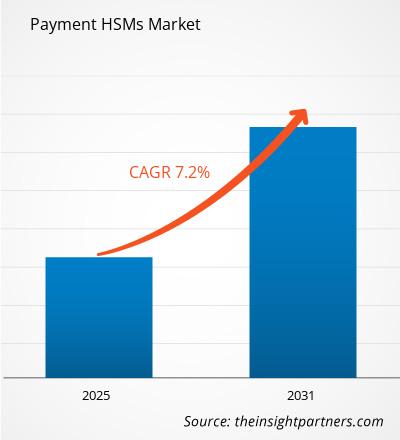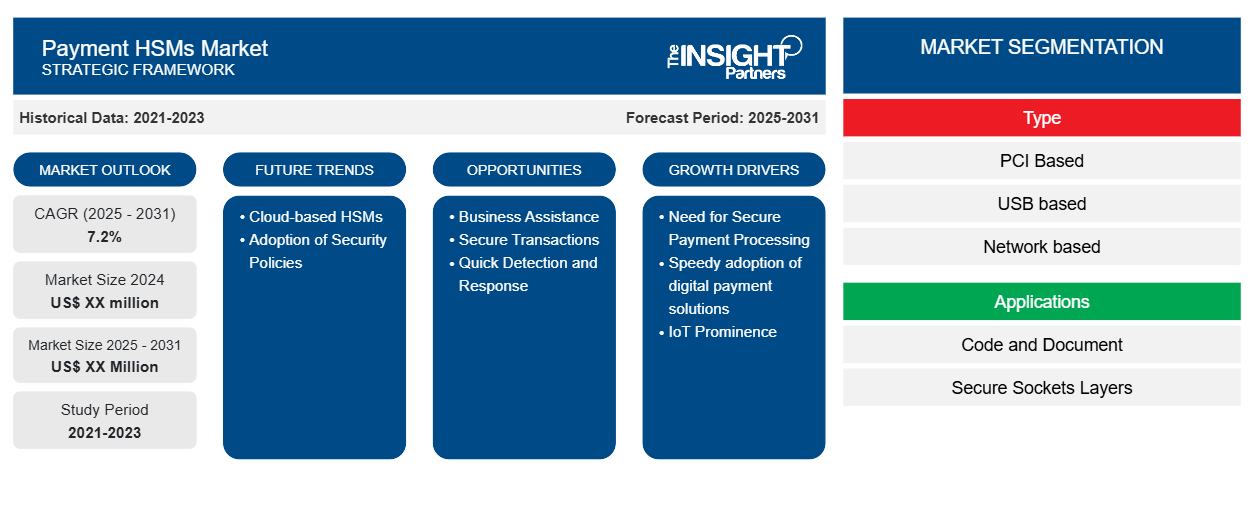Le marché des HSM de paiement devrait enregistrer un TCAC de 7,2 % de 2023 à 2031, avec une taille de marché passant de XX millions USD en 2023 à XX millions USD d'ici 2031.
Le rapport d’étude de marché sur les modules de sécurité matérielle de paiement (HSM) donne un aperçu du marché existant et des tendances ainsi que du potentiel de croissance future du marché, sous les facteurs clés qui stimulent l’industrie. Le marché est divisé en type, applications et utilisateur final.
L’analyse mondiale est ensuite divisée au niveau régional, où les marchés clés sont développés en Amérique du Nord, en Europe, en Asie-Pacifique, en Amérique latine et au Moyen-Orient et en Afrique. Cette segmentation permettra aux parties prenantes de comprendre les tendances locales, les environnements réglementaires et les opportunités de croissance spécifiques à chaque région. Dans cette évaluation du marché, nous la présenterions en dollars américains (US$) pour l’analyse segmentaire qui a été discutée ci-dessus.
Objectif du rapport
Le rapport Payment HSMs Market de The Insight Partners vise à décrire le paysage actuel et la croissance future, les principaux facteurs moteurs, les défis et les opportunités. Cela fournira des informations à diverses parties prenantes commerciales, telles que :
- Fournisseurs/fabricants de technologie : pour comprendre l’évolution de la dynamique du marché et connaître les opportunités de croissance potentielles, leur permettant de prendre des décisions stratégiques éclairées.
- Investisseurs : Effectuer une analyse complète des tendances concernant le taux de croissance du marché, les projections financières du marché et les opportunités qui existent tout au long de la chaîne de valeur.
- Organismes de réglementation : Réglementer les politiques et surveiller les activités du marché dans le but de minimiser les abus, de préserver la confiance des investisseurs et de maintenir l’intégrité et la stabilité du marché.
Segmentation du marché des HSM de paiement
Taper
- Basé sur PCI
- Basé sur USB
- Basé sur le réseau
Applications
- Code et Document
- Couches de sockets sécurisées
Utilisateur final
- BFSI
- Gouvernement
- Technologie et communication
- Industrie manufacturière
- Vente au détail et produits de consommation
- autres
Géographie
- Amérique du Nord
- Europe
- Asie-Pacifique
- Amérique du Sud et Amérique centrale
- Moyen-Orient et Afrique
Géographie
- Amérique du Nord
- Europe
- Asie-Pacifique
- Amérique du Sud et Amérique centrale
- Moyen-Orient et Afrique
Personnalisez ce rapport en fonction de vos besoins
Vous bénéficierez d'une personnalisation gratuite de n'importe quel rapport, y compris de certaines parties de ce rapport, d'une analyse au niveau des pays, d'un pack de données Excel, ainsi que de superbes offres et réductions pour les start-ups et les universités.
- Obtenez les principales tendances clés du marché de ce rapport.Cet échantillon GRATUIT comprendra une analyse de données, allant des tendances du marché aux estimations et prévisions.
Facteurs de croissance du marché des HSM de paiement
- Besoin d'un traitement sécurisé des paiements : Le marché des modules de sécurité matérielle des paiements (HSM) connaît une croissance en raison de divers facteurs critiques et réitère le besoin de solutions de traitement des paiements sécurisées dans l'environnement numérique contemporain. La sécurité des données est l'un des facteurs les plus sensibles à cet égard, étant donné que les cyberattaques associées aux violations de données deviennent très fréquentes. Les organisations sont désormais très conscientes de la protection des informations de paiement sensibles. Les HSM constituent une couche de sécurité essentielle car ils assurent la gestion sécurisée des clés cryptographiques et conservent les données de transaction cryptées pour empêcher tout accès non autorisé et toute fraude aux paiements.
- Adoption rapide des solutions de paiement numérique : les gens ont commencé à passer rapidement des transactions en espèces aux transactions sans espèces à un rythme encore plus rapide en raison de la croissance du commerce électronique et de la prolifération des plateformes de paiement mobile. Selon le rapport de la Federal Trade Commission (FTC) de 2020, les consommateurs ont subi environ 3,3 milliards de dollars de pertes dues à la fraude, ce qui souligne le besoin urgent de stratégies de sécurité solides. En effet, les HSM remplissent une fonction vitale : une gestion robuste des clés et un cryptage des transactions.
- Importance de l'IoT : Le nombre croissant d'appareils IoT signifie donc que l'utilisation des HSM de paiement est également en hausse. Avec l'importance croissante de l'IoT dans l'écosystème des paiements, les cybercriminels disposent de surfaces d'attaque plus grandes. Les HSM de paiement garantissent une communication sécurisée et la protection des données au sein des objets connectés, préservant ainsi l'intégrité des transactions de paiement. Cela est important car les industries intègrent de plus en plus de solutions IoT dans leurs opérations.
Tendances futures du marché des HSM de paiement
- Modules de sécurité matérielle (HSM) basés sur le cloud : le marché des modules de sécurité matérielle (HSM) de paiement connaît des tendances changeantes, qui reflètent l'évolution de l'horizon de la sécurité des paiements. Par exemple, les organisations ont tendance à choisir des solutions HSM basées sur le cloud, qui les aident à améliorer leur évolutivité et à réduire le coût des opérations.
- Adoption de politiques de sécurité : les paiements mobiles devraient atteindre 6,6 billions de dollars en 2022, et le traitement sécurisé des transactions est considéré comme le principal objectif commercial en matière de protection des données des consommateurs. D'autres exigences réglementaires, comme la norme PCI DSS, dictent également les dépenses des organisations en matière de HSM, qui répondent aux exigences basées sur les politiques de sécurité strictes adoptées.
Opportunités de marché pour les HSM de paiement
- Assistance aux entreprises : les HSM joueront un rôle essentiel pour aider les entreprises à répondre à certaines de ces demandes. Les entreprises dotées de solutions HSM facilitant la conformité réglementaire seront celles qui bénéficieront le plus de cet environnement en développement.
- Transactions sécurisées : Avec la pénétration croissante des appareils IoT, la sécurité est devenue unique et les HSM sont bien préparés pour y faire face. La communication sécurisée et la protection des données sont désormais essentielles une fois que l'IoT a été intégré au paiement. C'est là que les fournisseurs de HSM ont la possibilité de créer des solutions spécifiques en fonction des besoins de sécurité spécifiques de l'application IoT, garantissant des transactions sécurisées dans un monde connecté.
- Détection et réponse rapides : La demande croissante de fonctionnalités de sécurité avancées, les HSM utilisant des niveaux de menace de plus en plus élevés dans le monde cybernétique, les obligeront à proposer des services améliorés pour sécuriser les informations. Grâce à des technologies de pointe telles que l'intelligence artificielle (IA) et l'apprentissage automatique (ML), le HSM peut améliorer la détection et la réponse rapides à ces menaces avancées, aidant ainsi les organisations à se défendre.
Aperçu régional du marché des HSM de paiement
Les tendances et facteurs régionaux influençant le marché des HSM de paiement tout au long de la période de prévision ont été expliqués en détail par les analystes d'Insight Partners. Cette section traite également des segments et de la géographie du marché des HSM de paiement en Amérique du Nord, en Europe, en Asie-Pacifique, au Moyen-Orient et en Afrique, ainsi qu'en Amérique du Sud et en Amérique centrale.

- Obtenez les données régionales spécifiques au marché des HSM de paiement
Portée du rapport sur le marché des HSM de paiement
| Attribut de rapport | Détails |
|---|---|
| Taille du marché en 2023 | XX millions de dollars américains |
| Taille du marché d'ici 2031 | XX millions de dollars américains |
| Taux de croissance annuel composé mondial (2023-2031) | 7,2% |
| Données historiques | 2021-2022 |
| Période de prévision | 2024-2031 |
| Segments couverts | Par type
|
| Régions et pays couverts | Amérique du Nord
|
| Leaders du marché et profils d'entreprises clés |
|
Densité des acteurs du marché des HSM de paiement : comprendre son impact sur la dynamique des entreprises
Le marché des HSM de paiement connaît une croissance rapide, tirée par la demande croissante des utilisateurs finaux en raison de facteurs tels que l'évolution des préférences des consommateurs, les avancées technologiques et une plus grande sensibilisation aux avantages du produit. À mesure que la demande augmente, les entreprises élargissent leurs offres, innovent pour répondre aux besoins des consommateurs et capitalisent sur les tendances émergentes, ce qui alimente davantage la croissance du marché.
La densité des acteurs du marché fait référence à la répartition des entreprises ou des sociétés opérant sur un marché ou un secteur particulier. Elle indique le nombre de concurrents (acteurs du marché) présents sur un marché donné par rapport à sa taille ou à sa valeur marchande totale.
Les principales entreprises opérant sur le marché des HSM de paiement sont :
- Gemalto NV
- Thales e-Security, Inc.
- Utimaco GmbH
- Société IBM
- FuturX
Avis de non-responsabilité : les sociétés répertoriées ci-dessus ne sont pas classées dans un ordre particulier.

- Obtenez un aperçu des principaux acteurs du marché des HSM de paiement
Principaux arguments de vente
- Couverture complète : Le rapport couvre de manière exhaustive l’analyse des produits, des services, des types et des utilisateurs finaux du marché des HSM de paiement, offrant un paysage holistique.
- Analyse d’experts : Le rapport est compilé sur la base d’une compréhension approfondie des experts et analystes du secteur.
- Informations à jour : Le rapport garantit la pertinence commerciale en raison de sa couverture des informations récentes et des tendances des données.
- Options de personnalisation : ce rapport peut être personnalisé pour répondre aux exigences spécifiques du client et s'adapter parfaitement aux stratégies commerciales.
Le rapport de recherche sur le marché des HSM de paiement peut donc aider à ouvrir la voie au décodage et à la compréhension du scénario de l’industrie et des perspectives de croissance. Bien qu’il puisse y avoir quelques préoccupations valables, les avantages globaux de ce rapport ont tendance à l’emporter sur les inconvénients.
- Analyse historique (2 ans), année de base, prévision (7 ans) avec TCAC
- Analyse PEST et SWOT
- Taille du marché Valeur / Volume - Mondial, Régional, Pays
- Industrie et paysage concurrentiel
- Ensemble de données Excel
Rapports récents
Rapports connexes
Témoignages
Raison d'acheter
- Prise de décision éclairée
- Compréhension de la dynamique du marché
- Analyse concurrentielle
- Connaissances clients
- Prévisions de marché
- Atténuation des risques
- Planification stratégique
- Justification des investissements
- Identification des marchés émergents
- Amélioration des stratégies marketing
- Amélioration de l'efficacité opérationnelle
- Alignement sur les tendances réglementaires





















 Obtenez un échantillon gratuit pour - Marché des HSM de paiement
Obtenez un échantillon gratuit pour - Marché des HSM de paiement